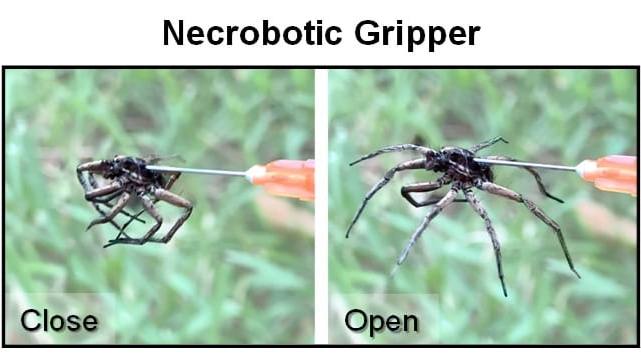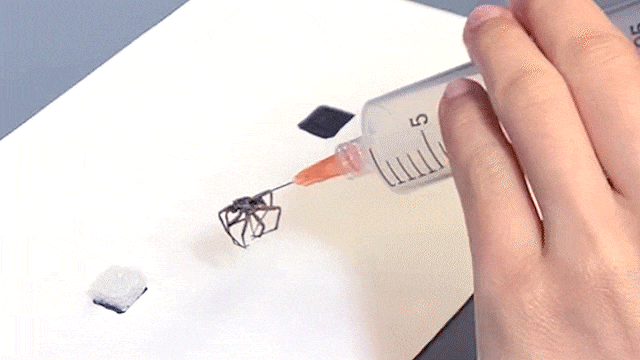
ARTICLE – Don’t laugh (or cringe?), but I recently came across a really interesting article about using dead spiders as ready-to-use actuators (a mechanical device for moving or controlling something -Merriam-Webster Dictionary). Some researchers at Rice University noticed that the natural state of a dead spider has its legs curled up, so why not use this to grip things?
According to their article “Necrobotics: Biotic Materials as Ready-to-Use Actuators“, when spiders are alive, they move their legs using hydraulic pressure; whereas many animals like mammals have opposing muscle groups called extensor and flexor muscles that achieve movement. The article further states that spiders only have flexor muscles in their legs that contract the legs inward and use hydraulic pressure from the spider’s hemolymph or blood to extend their legs outward. Thus, when the spider dies, the hydraulic pressure no longer exists to exert a force to oppose the flexor muscles, and thus the legs end up in a curled-up position.
The researchers decided to create some tests to see if they could use the neutral curled position of a deceased spider to grip small items.
The benefit of using deceased spiders as grippers is that there is very little cost involved because they are ready to be used versus manufacturing an equally complex gripper. They also don’t require complex machinery to use them and can grip small fragile items.

All you need to do to use a spider as a ready-made necrobotic gripper is to add pressure to the dead spider’s legs to extend them to grab an item. The researchers accomplished this by inserting a hypodermic needle into the prosoma (the area of the spider’s body that contains the legs) of a wolf spider and applying a drop of cyanoacrylate glue to seal the needle puncture on the body of the spider to create a seal so that pressure could be applied.

According to their research paper, “The typical pressure in the legs of a resting spider ranges from 4.0 kPa to 6.1 kPa,[41] so we chose the opening pressure of 5.5 kPa within this range to avoid damaging the necrobotic gripper [you don’t want to blow up your dead spider] while also ensuring that the gripper leg span has enough clearance to grasp the object.”
What I thought was clever about using deceased spiders as grippers is that there is no energy needed to maintain a grip on a small object because that is the deceased spider’s neutral position.
They also noticed that the necrobotic gripper was able to grip rough items 2.5 times its size without fully encompassing those items. They hypothesized that tiny hairs on the spider’s legs helped it to adhere to the object. This might help in grasping smooth objects too.
Additionally, they found that the size of the spider matters when it comes to gripping force:
…the jumping spider of the family Salticidae, which has a mass of 10–25 mg, would be able to exert a gripping force of over 200% its own weight. In contrast, a larger spider would not be able to hold as much weight relative to its bodyweight (e.g., the Goliath birdeater tarantula of the family Theraphosidae, which has a mass of ≈200 g, would only be able to grasp an object approximately 10% its own weight).
They tested picking up red cellulose acetate beads of varying sizes and also found that the gripper was able to pick up a spider that was 1.3 times heavier than the necrobotic gripper.
Here’s more of this innovative necrobot in action (from the Rice University news webpage). Fascinating eh?!?


The downside to using deceased spiders as ready-made actuators is that they start to dry out after a couple of days. To combat this, the researchers suggest coating the spiders with something like beeswax, etc. to reduce the desiccation rate to extend the use of the gripper.
Creepy or cool? I vote “cool” with just a smidge of “creepy” 🙂



Gadgeteer Comment Policy - Please read before commenting
“Your scientists were so preoccupied with whether they could, they didn’t stop to think if they should.”